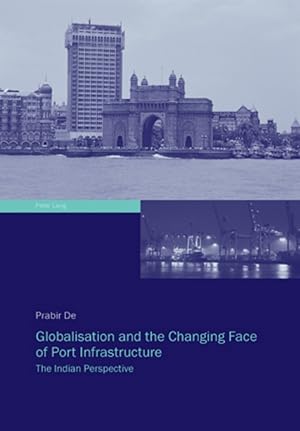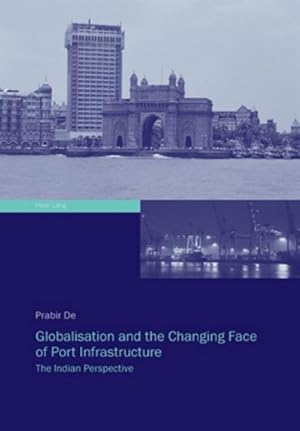globalisation changing face port von prabir (2 Ergebnisse)
Produktart
- Alle Produktarten
- Bücher (2)
- Magazine & Zeitschriften
- Comics
- Noten
- Kunst, Grafik & Poster
- Fotografien
- Karten
-
Manuskripte &
Papierantiquitäten
Zustand
Einband
- alle Einbände
- Hardcover
- Softcover
Weitere Eigenschaften
- Erstausgabe
- Signiert
- Schutzumschlag
- Angebotsfoto
Land des Verkäufers
Verkäuferbewertung
-
Globalisation and the changing face of port infrastructure : the Indian perspective.
Verlag: Bern ; Berlin ; Bruxelles ; Frankfurt am Main ; New York, NY ; Oxford ; Wien : Lang, 2009
ISBN 10: 3034300050ISBN 13: 9783034300056
Anbieter: Fundus-Online GbR Borkert Schwarz Zerfaß, Berlin, Deutschland
Buch
Pp. Zustand: Wie neu. XIV, 186 S. : graph. Darst. ; 22 cm Tadelloses Exemplar. - Contents -- Preface ix -- List of Tables, Figures and Appendices xi -- List of Abbreviations xii -- 1. Introduction 1 -- 1.1 Objective 9 -- 1.2 Outline of the Book 10 -- 1.3 Concept of Port and Related Studies 12 -- 1.4 Overview of Indian Ports: Pre-Independence Period 16 -- 1.5 Development of Ports: Post-Independence Period 18 -- 1.6 Institutional Set-up 21 -- 1.7 Profile of Indian Ports 22 -- 2. Impact of Performance Indicators and Labour Endowment -- on Port Traffic 31 -- 2.1 Introduction 31 -- 2.2 Data and Methodology 33 -- 2.3 Linkage between Traffic and Performance 46 -- 2.4 Policy Implications 52 -- 2.5 Concluding Remarks 57 -- 3. Causality between Port Performance and Port Traffic 61 -- 3.1 Introduction 61 -- 3.2 Data and Methodology 64 -- 3.3 Measures of Port Performance 65 -- 3.4 Causality between Performance and Traffic 67 -- 3.5 Conclusions 77 -- 4. Total Factor Productivity Growth in Ports 81 -- 4.1 Introduction 81 -- 4.2 Productivity and Efficiency Concepts 82 -- 4.3 Empirical Results on TFP Changes 91 -- 4.4 Summary and Conclusions 103 -- 5. Productivity, Efficiency and Technological Change -- in Ports 107 -- 5.1 Introduction 107 -- 5.2 The Data 110 -- 5.3 Concept and Measurement of Efficiency 111 -- 5.4 The Empirical Test of Efficiency 114 -- 5.5 Factors Influencing LP 123 -- 5.6 Summary and Implications 131 -- 6. Concentration and Competition in Ports 135 -- 6.1 Introduction 135 -- 6.2 Data and Methodology 138 -- 6.3 Inter-port Comparison of Traffic over Time 139 -- 6.4 Relationship between Port Performance, -- Cargo Composition and Hinterland's Output 143 -- 6.5 Openness, Port Traffic and Port Capacity 144 -- 6.6 Port Reform and Concentration of Private -- Terminal Operators in India 150 -- 6.7 Public Investment and Regulation 155 -- 6.8 Conclusions 161 -- 7. Summary and Policy Implications 165 -- 7.1 Summary 165 -- 7.2 Implications for Future Research 168 -- Bibliography 171 -- Index 183 ISBN 9783034300056 Sprache: Englisch Gewicht in Gramm: 338.
-
Globalisation and the Changing Face of Port Infrastructure : The Indian Perspective
Verlag: Peter Lang, 2009
ISBN 10: 3034300050ISBN 13: 9783034300056
Anbieter: AHA-BUCH GmbH, Einbeck, Deutschland
Buch
Buch. Zustand: Neu. Druck auf Anfrage Neuware - Printed after ordering - Inefficient ports can stall a country's trade growth and also increase the costs of transportation. Rising inefficiencies in ports have therefore forced the governments all over the world to deregulate the port system. The port sector in several developing countries has been undergoing revolutionary transformation from a subsistence infrastructure resource into a more capital intensive, commercially oriented facility during the last two decades. In India, awareness towards the impact of port infrastructure on economic development in general and international trade in particular has increased in recent years partly as a result of rising trade transportation costs. One of the objectives of this book is therefore to understand the role the port plays in India's economic development. The book tries to quantitatively evaluate the structural metamorphosis in Indian port sector. The main emphasis of the book is on performance evaluation, technological change, total factor productivity growth, market concentration, and competitiveness of Indian ports for the last two and a half decades. This book deals with these vital issues and questions through a detailed analytical framework. Above all, one protracted objective of this book is to create a ground for discussion on various aspects of port development and the resultant policy action.



